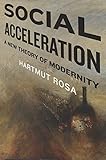Social Acceleration : A New Theory of Modernity / Hartmut Rosa.
Material type: TextSeries: New Directions in Critical Theory ; 32Publisher: New York, NY : Columbia University Press, [2013]Copyright date: ©2013Description: 1 online resource (512 p.) : 13 illus.; 3 TablesContent type:
TextSeries: New Directions in Critical Theory ; 32Publisher: New York, NY : Columbia University Press, [2013]Copyright date: ©2013Description: 1 online resource (512 p.) : 13 illus.; 3 TablesContent type: - 9780231148344
- 9780231519885
- HM656 .R6713 2013
- online - DeGruyter
- Issued also in print.
| Item type | Current library | Call number | URL | Status | Notes | Barcode | |
|---|---|---|---|---|---|---|---|
 eBook
eBook
|
Biblioteca "Angelicum" Pont. Univ. S.Tommaso d'Aquino Nuvola online | online - DeGruyter (Browse shelf(Opens below)) | Online access | Not for loan (Accesso limitato) | Accesso per gli utenti autorizzati / Access for authorized users | (dgr)9780231519885 |
Browsing Biblioteca "Angelicum" Pont. Univ. S.Tommaso d'Aquino shelves, Shelving location: Nuvola online Close shelf browser (Hides shelf browser)
Frontmatter -- Contents -- Illustrations -- Translator's Introduction: Modernity and Time -- In Place of a Preface -- Introduction -- Part 1. The Categorial Framework of a Systematic Theory of Social Acceleration -- 1. From the Love of Movement to the Law of Acceleration: Observations of Modernity -- 2. What Is Social Acceleration? -- Part 2. Mechanisms and Manifestations: A Phenomenology of Social Acceleration -- 3. Technical Acceleration And The Revolutionizing Of The Space-Time Regime -- 4. Slipping Slopes: The Acceleration Of Social Change And The Increase Of Contingency -- 5. The Acceleration Of The "Pace Of Life" And Paradoxes In The Experience Of Time -- Part 3. Causes -- 6. The Speeding Up of Society as a Self-Propelling Process: The Circle of Acceleration -- 7. Acceleration and Growth: External Drivers of Social Acceleration -- 8. Power, War, and Speed: State and Military as Key Institutional Accelerators -- Part 4. Consequences -- 9. Acceleration, Globalization, Postmodernity -- 10. Situational Identity: Of Drifters and Players -- 11. Situational Politics: Paradoxical Time Horizons Between Desynchronization and Disintegration -- 12. Acceleration and Rigidity: An Attempt at a Redefinition of Modernity -- Conclusion: Frenetic Standstill? The End of History -- Notes -- Bibliography -- Index
restricted access online access with authorization star
http://purl.org/coar/access_right/c_16ec
Hartmut Rosa advances an account of the temporal structure of society from the perspective of critical theory. He identifies three categories of change in the tempo of modern social life: technological acceleration, evident in transportation, communication, and production; the acceleration of social change, reflected in cultural knowledge, social institutions, and personal relationships; and acceleration in the pace of life, which happens despite the expectation that technological change should increase an individual's free time.According to Rosa, both the structural and cultural aspects of our institutions and practices are marked by the "shrinking of the present," a decreasing time period during which expectations based on past experience reliably match the future. When this phenomenon combines with technological acceleration and the increasing pace of life, time seems to flow ever faster, making our relationships to each other and the world fluid and problematic. It is as if we are standing on "slipping slopes," a steep social terrain that is itself in motion and in turn demands faster lives and technology. As Rosa deftly shows, this self-reinforcing feedback loop fundamentally determines the character of modern life.
Issued also in print.
Mode of access: Internet via World Wide Web.
In English.
Description based on online resource; title from PDF title page (publisher's Web site, viewed 02. Mrz 2022)









